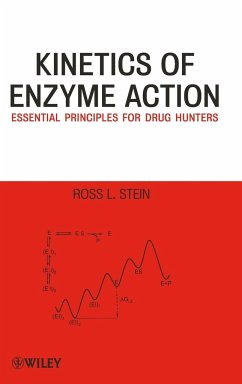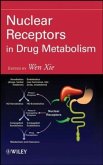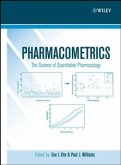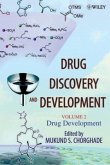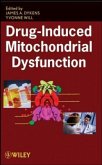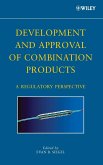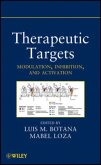- Gebundenes Buch
- Merkliste
- Auf die Merkliste
- Bewerten Bewerten
- Teilen
- Produkt teilen
- Produkterinnerung
- Produkterinnerung
Few scientists have the knowledge to perform the studies that are necessary to discover and characterize enzyme inhibitors, despite the vested interest the pharmaceutical industry has in this field. Beginning with the most basic principles pertaining to simple, one-substrate enzyme reactions and their inhibitors, and progressing to a thorough treatment of two-substrate enzymes, Kinetics of Enzyme Action: Essential Principles for Drug Hunters provides biochemists, medicinal chemists, and pharmaceutical scientists with numerous case study examples to outline the tools and techniques necessary to…mehr
Andere Kunden interessierten sich auch für
![Development of Therapeutic Agents Handbook Development of Therapeutic Agents Handbook]() Development of Therapeutic Agents Handbook300,99 €
Development of Therapeutic Agents Handbook300,99 €![Nuclear Receptors in Drug Metabolism Nuclear Receptors in Drug Metabolism]() Nuclear Receptors in Drug Metabolism144,99 €
Nuclear Receptors in Drug Metabolism144,99 €![Pharmacometrics Pharmacometrics]() Ene I. Ette / Paul J. Williams (eds.)Pharmacometrics247,99 €
Ene I. Ette / Paul J. Williams (eds.)Pharmacometrics247,99 €![Drug Discovery and Development, Volume 2 Drug Discovery and Development, Volume 2]() Mukund S. Chorghade (ed.)Drug Discovery and Development, Volume 2166,99 €
Mukund S. Chorghade (ed.)Drug Discovery and Development, Volume 2166,99 €![Drug-Induced Mitochondrial Dysfunction Drug-Induced Mitochondrial Dysfunction]() Drug-Induced Mitochondrial Dysfunction204,99 €
Drug-Induced Mitochondrial Dysfunction204,99 €![Combination Drug Products Combination Drug Products]() Combination Drug Products117,99 €
Combination Drug Products117,99 €![Therapeutic Targets Therapeutic Targets]() Luis M BotanaTherapeutic Targets173,99 €
Luis M BotanaTherapeutic Targets173,99 €-
-
-
Few scientists have the knowledge to perform the studies that are necessary to discover and characterize enzyme inhibitors, despite the vested interest the pharmaceutical industry has in this field. Beginning with the most basic principles pertaining to simple, one-substrate enzyme reactions and their inhibitors, and progressing to a thorough treatment of two-substrate enzymes, Kinetics of Enzyme Action: Essential Principles for Drug Hunters provides biochemists, medicinal chemists, and pharmaceutical scientists with numerous case study examples to outline the tools and techniques necessary to perform, understand, and interpret detailed kinetic studies for drug discovery.
Hinweis: Dieser Artikel kann nur an eine deutsche Lieferadresse ausgeliefert werden.
Hinweis: Dieser Artikel kann nur an eine deutsche Lieferadresse ausgeliefert werden.
Produktdetails
- Produktdetails
- Verlag: Wiley & Sons
- Artikelnr. des Verlages: 14541411000
- 1. Auflage
- Seitenzahl: 320
- Erscheinungstermin: 23. August 2011
- Englisch
- Abmessung: 240mm x 161mm x 22mm
- Gewicht: 611g
- ISBN-13: 9780470414118
- ISBN-10: 0470414111
- Artikelnr.: 33255093
- Herstellerkennzeichnung
- Libri GmbH
- Europaallee 1
- 36244 Bad Hersfeld
- gpsr@libri.de
- Verlag: Wiley & Sons
- Artikelnr. des Verlages: 14541411000
- 1. Auflage
- Seitenzahl: 320
- Erscheinungstermin: 23. August 2011
- Englisch
- Abmessung: 240mm x 161mm x 22mm
- Gewicht: 611g
- ISBN-13: 9780470414118
- ISBN-10: 0470414111
- Artikelnr.: 33255093
- Herstellerkennzeichnung
- Libri GmbH
- Europaallee 1
- 36244 Bad Hersfeld
- gpsr@libri.de
ROSS L. STEIN received his PhD in physical organic chemistry from Indiana University in 1978, after which he conducted post-doctoral research in mechanistic enzymology at the University of Kansas. His career has included positions at Merck, where he headed the Enzymology Department, and ProScript (acquired by Millennium in 1999) as vice president of biochemistry. At ProScript, Dr. Stein was instrumental in the pre-clinical development and co-inventor of the drug VELCADETM, a proteasome inhibitor used to treat multiple myeloma. In 2001, he accepted a position at Harvard Medical School to establish and head the Laboratory for Drug Discovery in Neurodegeneration. Most recently, from 2009-2011, Dr. Stein was vice president of drug discovery at Sirtris Pharmaceuticals.
Preface xi
1 Introduction 1
1.1 A Brief History of Enzymology 2
1.2 Goal of Enzymology: The Elucidation of Mechanism 11
1.3 The Emergence of Mechanism from Data 13
2 Kinetics of Single-substrate Enzymatic Reactions 19
2.1 The Dependence of Initial Velocity on Substrate Concentration and the
Requirement for an E : S Complex 19
2.2 Derivation of the Rate Equation for a Single-Substrate Reaction with
the Assumption of Rapid Equilibrium 21
2.3 Derivation of Rate Equations Using the Steady-State Assumption 24
2.4 Methods of Enzyme Assay 26
2.5 Enzyme Kinetics Practicum: Assay Development, Experimental Design, Data
Collection, and Data Analysis 32
3 Kinetics of Single-substrate Enzymatic Reactions: Special Topics 41
3.1 Transition State Theory and Free Energy Diagrams 41
3.2 Kinetic Consequences of an Enzyme : Substrate Complex 46
3.3 Reactions with More Than One Intermediary Complex 51
3.4 Deviations from Michaelis-Menten Kinetics 53
3.5 Kinetics of Enzymatic Action on Substrates with Multiple Reactive
Centers 65
4 Enzyme Inhibition: the Phenomenon and Mechanism-independent Analysis 73
4.1 Enzyme Inhibition: The Phenomenon 74
4.2 Enzyme Inhibition: The First Quantitative Steps 76
4.3 Enzyme-Inhibitor Systems Misbehaving 77
4.4 Case Studies 83
5 Kinetic Mechanism of Inhibition of One-substrate Enzymatic Reactions 89
5.1 Importance in Drug Discovery 89
5.2 Theoretical Considerations 90
5.3 Analysis of Initial Velocity Data for Enzyme Inhibition 96
5.4 Inhibition of One-Substrate, Two-Intermediate Reactions 108
5.5 Inhibition by Depletion of Substrate 111
6 Tight-binding, Slow-binding, and Irreversible Inhibition 115
6.1 Importance in Drug Discovery 115
6.2 Tight-Binding Inhibition 116
6.3 Slow-Binding Inhibition 122
6.4 Irreversible Inhibition 137
7 Kinetics of Two-substrate Enzymatic Reactions 141
7.1 Importance in Drug Discovery 141
7.2 Basic Mechanisms 142
7.3 Conceptual Understanding of Sequential Mechanisms 143
7.4 Derivation of Rate Equations for Sequential Mechanisms 147
7.5 Ping-Pong Mechanisms 153
7.6 Determining the Kinetic Mechanism for Two-Substrate Reactions 156
7.7 A Conceptual Understanding of the Shapes of Secondary Plots 163
7.8 Mistaken Identity: Rapid Equilibrium Random Versus Steady-State Ordered
168
8 Kinetic Mechanism of Inhibition of Two-substrate Enzymatic Reactions 169
8.1 Importance in Drug Discovery 170
8.2 Mechanisms of Inhibition of Two-Substrate Reactions 170
8.3 Inhibition by Substrate Analogs 185
8.4 Analysis of Sequential Reactions in which Inhibitor Binds to Enzyme :
Product Complexes 191
8.5 Driving SAR Programs for Two-Substrate Enzymatic Reactions 196
9 Allosteric Modulation of Enzyme Activity 199
9.1 Mechanisms of Enzyme Modulation 201
9.2 Kinetics of Allosteric Modulation 202
9.3 Meaning of ß and ¿ 208
9.4 Case Studies: Dependence of Allosteric Modulation on Structural
Features of the Substrate 212
10 Kinetics-based Probes of Mechanism 219
10.1 pH Dependence of Enzymatic Reactions 220
10.2 Temperature Dependence of Enzymatic Reactions 229
10.3 Viscosity Dependence of Enzymatic Reactions 235
10.4 Kinetic Isotope Effects on Enzyme-Catalyzed Reactions 239
Appendix A Basic Principles of Chemical Kinetics 251
A.1 One-Step, Irreversible, Unimolecular Reactions 252
A.2 One-Step, Irreversible, Bimolecular Reactions 253
A.3 One-Step, Reversible Reactions 254
A.4 Two-Step, Irreversible Reactions 257
A.5 Two-Step Reaction, with Reversible First Step 259
Appendix B Transition State Theory and Enzymology: Enzyme Catalytic Power
and Inhibitor Design 263
B.1 Catalytic Power of Enzymes 263
B.2 Transition State Analog Inhibition 268
Appendix C Selecting Substrate Concentrations for High-throughput Screens
275
C.1 Balancing the Steady State for One-Substrate Reactions 276
C.2 Balancing the Steady State for Two-Substrate, Rapid Equilibrium-Ordered
Enzymatic Reactions 276
C.3 Balancing the Steady State for Two-Substrate, Rapid Equilibrium Random
Enzymatic Reactions 279
C.4 Balancing the Steady State for Nonequilibrium Enzymatic Reactions
Involving a Second Steady-State Intermediate 282
C.5 Balancing the Steady State for Two-Substrate, Ping-Pong Enzymatic
Reactions 283
Index 287
1 Introduction 1
1.1 A Brief History of Enzymology 2
1.2 Goal of Enzymology: The Elucidation of Mechanism 11
1.3 The Emergence of Mechanism from Data 13
2 Kinetics of Single-substrate Enzymatic Reactions 19
2.1 The Dependence of Initial Velocity on Substrate Concentration and the
Requirement for an E : S Complex 19
2.2 Derivation of the Rate Equation for a Single-Substrate Reaction with
the Assumption of Rapid Equilibrium 21
2.3 Derivation of Rate Equations Using the Steady-State Assumption 24
2.4 Methods of Enzyme Assay 26
2.5 Enzyme Kinetics Practicum: Assay Development, Experimental Design, Data
Collection, and Data Analysis 32
3 Kinetics of Single-substrate Enzymatic Reactions: Special Topics 41
3.1 Transition State Theory and Free Energy Diagrams 41
3.2 Kinetic Consequences of an Enzyme : Substrate Complex 46
3.3 Reactions with More Than One Intermediary Complex 51
3.4 Deviations from Michaelis-Menten Kinetics 53
3.5 Kinetics of Enzymatic Action on Substrates with Multiple Reactive
Centers 65
4 Enzyme Inhibition: the Phenomenon and Mechanism-independent Analysis 73
4.1 Enzyme Inhibition: The Phenomenon 74
4.2 Enzyme Inhibition: The First Quantitative Steps 76
4.3 Enzyme-Inhibitor Systems Misbehaving 77
4.4 Case Studies 83
5 Kinetic Mechanism of Inhibition of One-substrate Enzymatic Reactions 89
5.1 Importance in Drug Discovery 89
5.2 Theoretical Considerations 90
5.3 Analysis of Initial Velocity Data for Enzyme Inhibition 96
5.4 Inhibition of One-Substrate, Two-Intermediate Reactions 108
5.5 Inhibition by Depletion of Substrate 111
6 Tight-binding, Slow-binding, and Irreversible Inhibition 115
6.1 Importance in Drug Discovery 115
6.2 Tight-Binding Inhibition 116
6.3 Slow-Binding Inhibition 122
6.4 Irreversible Inhibition 137
7 Kinetics of Two-substrate Enzymatic Reactions 141
7.1 Importance in Drug Discovery 141
7.2 Basic Mechanisms 142
7.3 Conceptual Understanding of Sequential Mechanisms 143
7.4 Derivation of Rate Equations for Sequential Mechanisms 147
7.5 Ping-Pong Mechanisms 153
7.6 Determining the Kinetic Mechanism for Two-Substrate Reactions 156
7.7 A Conceptual Understanding of the Shapes of Secondary Plots 163
7.8 Mistaken Identity: Rapid Equilibrium Random Versus Steady-State Ordered
168
8 Kinetic Mechanism of Inhibition of Two-substrate Enzymatic Reactions 169
8.1 Importance in Drug Discovery 170
8.2 Mechanisms of Inhibition of Two-Substrate Reactions 170
8.3 Inhibition by Substrate Analogs 185
8.4 Analysis of Sequential Reactions in which Inhibitor Binds to Enzyme :
Product Complexes 191
8.5 Driving SAR Programs for Two-Substrate Enzymatic Reactions 196
9 Allosteric Modulation of Enzyme Activity 199
9.1 Mechanisms of Enzyme Modulation 201
9.2 Kinetics of Allosteric Modulation 202
9.3 Meaning of ß and ¿ 208
9.4 Case Studies: Dependence of Allosteric Modulation on Structural
Features of the Substrate 212
10 Kinetics-based Probes of Mechanism 219
10.1 pH Dependence of Enzymatic Reactions 220
10.2 Temperature Dependence of Enzymatic Reactions 229
10.3 Viscosity Dependence of Enzymatic Reactions 235
10.4 Kinetic Isotope Effects on Enzyme-Catalyzed Reactions 239
Appendix A Basic Principles of Chemical Kinetics 251
A.1 One-Step, Irreversible, Unimolecular Reactions 252
A.2 One-Step, Irreversible, Bimolecular Reactions 253
A.3 One-Step, Reversible Reactions 254
A.4 Two-Step, Irreversible Reactions 257
A.5 Two-Step Reaction, with Reversible First Step 259
Appendix B Transition State Theory and Enzymology: Enzyme Catalytic Power
and Inhibitor Design 263
B.1 Catalytic Power of Enzymes 263
B.2 Transition State Analog Inhibition 268
Appendix C Selecting Substrate Concentrations for High-throughput Screens
275
C.1 Balancing the Steady State for One-Substrate Reactions 276
C.2 Balancing the Steady State for Two-Substrate, Rapid Equilibrium-Ordered
Enzymatic Reactions 276
C.3 Balancing the Steady State for Two-Substrate, Rapid Equilibrium Random
Enzymatic Reactions 279
C.4 Balancing the Steady State for Nonequilibrium Enzymatic Reactions
Involving a Second Steady-State Intermediate 282
C.5 Balancing the Steady State for Two-Substrate, Ping-Pong Enzymatic
Reactions 283
Index 287
Preface xi
1 Introduction 1
1.1 A Brief History of Enzymology 2
1.2 Goal of Enzymology: The Elucidation of Mechanism 11
1.3 The Emergence of Mechanism from Data 13
2 Kinetics of Single-substrate Enzymatic Reactions 19
2.1 The Dependence of Initial Velocity on Substrate Concentration and the
Requirement for an E : S Complex 19
2.2 Derivation of the Rate Equation for a Single-Substrate Reaction with
the Assumption of Rapid Equilibrium 21
2.3 Derivation of Rate Equations Using the Steady-State Assumption 24
2.4 Methods of Enzyme Assay 26
2.5 Enzyme Kinetics Practicum: Assay Development, Experimental Design, Data
Collection, and Data Analysis 32
3 Kinetics of Single-substrate Enzymatic Reactions: Special Topics 41
3.1 Transition State Theory and Free Energy Diagrams 41
3.2 Kinetic Consequences of an Enzyme : Substrate Complex 46
3.3 Reactions with More Than One Intermediary Complex 51
3.4 Deviations from Michaelis-Menten Kinetics 53
3.5 Kinetics of Enzymatic Action on Substrates with Multiple Reactive
Centers 65
4 Enzyme Inhibition: the Phenomenon and Mechanism-independent Analysis 73
4.1 Enzyme Inhibition: The Phenomenon 74
4.2 Enzyme Inhibition: The First Quantitative Steps 76
4.3 Enzyme-Inhibitor Systems Misbehaving 77
4.4 Case Studies 83
5 Kinetic Mechanism of Inhibition of One-substrate Enzymatic Reactions 89
5.1 Importance in Drug Discovery 89
5.2 Theoretical Considerations 90
5.3 Analysis of Initial Velocity Data for Enzyme Inhibition 96
5.4 Inhibition of One-Substrate, Two-Intermediate Reactions 108
5.5 Inhibition by Depletion of Substrate 111
6 Tight-binding, Slow-binding, and Irreversible Inhibition 115
6.1 Importance in Drug Discovery 115
6.2 Tight-Binding Inhibition 116
6.3 Slow-Binding Inhibition 122
6.4 Irreversible Inhibition 137
7 Kinetics of Two-substrate Enzymatic Reactions 141
7.1 Importance in Drug Discovery 141
7.2 Basic Mechanisms 142
7.3 Conceptual Understanding of Sequential Mechanisms 143
7.4 Derivation of Rate Equations for Sequential Mechanisms 147
7.5 Ping-Pong Mechanisms 153
7.6 Determining the Kinetic Mechanism for Two-Substrate Reactions 156
7.7 A Conceptual Understanding of the Shapes of Secondary Plots 163
7.8 Mistaken Identity: Rapid Equilibrium Random Versus Steady-State Ordered
168
8 Kinetic Mechanism of Inhibition of Two-substrate Enzymatic Reactions 169
8.1 Importance in Drug Discovery 170
8.2 Mechanisms of Inhibition of Two-Substrate Reactions 170
8.3 Inhibition by Substrate Analogs 185
8.4 Analysis of Sequential Reactions in which Inhibitor Binds to Enzyme :
Product Complexes 191
8.5 Driving SAR Programs for Two-Substrate Enzymatic Reactions 196
9 Allosteric Modulation of Enzyme Activity 199
9.1 Mechanisms of Enzyme Modulation 201
9.2 Kinetics of Allosteric Modulation 202
9.3 Meaning of ß and ¿ 208
9.4 Case Studies: Dependence of Allosteric Modulation on Structural
Features of the Substrate 212
10 Kinetics-based Probes of Mechanism 219
10.1 pH Dependence of Enzymatic Reactions 220
10.2 Temperature Dependence of Enzymatic Reactions 229
10.3 Viscosity Dependence of Enzymatic Reactions 235
10.4 Kinetic Isotope Effects on Enzyme-Catalyzed Reactions 239
Appendix A Basic Principles of Chemical Kinetics 251
A.1 One-Step, Irreversible, Unimolecular Reactions 252
A.2 One-Step, Irreversible, Bimolecular Reactions 253
A.3 One-Step, Reversible Reactions 254
A.4 Two-Step, Irreversible Reactions 257
A.5 Two-Step Reaction, with Reversible First Step 259
Appendix B Transition State Theory and Enzymology: Enzyme Catalytic Power
and Inhibitor Design 263
B.1 Catalytic Power of Enzymes 263
B.2 Transition State Analog Inhibition 268
Appendix C Selecting Substrate Concentrations for High-throughput Screens
275
C.1 Balancing the Steady State for One-Substrate Reactions 276
C.2 Balancing the Steady State for Two-Substrate, Rapid Equilibrium-Ordered
Enzymatic Reactions 276
C.3 Balancing the Steady State for Two-Substrate, Rapid Equilibrium Random
Enzymatic Reactions 279
C.4 Balancing the Steady State for Nonequilibrium Enzymatic Reactions
Involving a Second Steady-State Intermediate 282
C.5 Balancing the Steady State for Two-Substrate, Ping-Pong Enzymatic
Reactions 283
Index 287
1 Introduction 1
1.1 A Brief History of Enzymology 2
1.2 Goal of Enzymology: The Elucidation of Mechanism 11
1.3 The Emergence of Mechanism from Data 13
2 Kinetics of Single-substrate Enzymatic Reactions 19
2.1 The Dependence of Initial Velocity on Substrate Concentration and the
Requirement for an E : S Complex 19
2.2 Derivation of the Rate Equation for a Single-Substrate Reaction with
the Assumption of Rapid Equilibrium 21
2.3 Derivation of Rate Equations Using the Steady-State Assumption 24
2.4 Methods of Enzyme Assay 26
2.5 Enzyme Kinetics Practicum: Assay Development, Experimental Design, Data
Collection, and Data Analysis 32
3 Kinetics of Single-substrate Enzymatic Reactions: Special Topics 41
3.1 Transition State Theory and Free Energy Diagrams 41
3.2 Kinetic Consequences of an Enzyme : Substrate Complex 46
3.3 Reactions with More Than One Intermediary Complex 51
3.4 Deviations from Michaelis-Menten Kinetics 53
3.5 Kinetics of Enzymatic Action on Substrates with Multiple Reactive
Centers 65
4 Enzyme Inhibition: the Phenomenon and Mechanism-independent Analysis 73
4.1 Enzyme Inhibition: The Phenomenon 74
4.2 Enzyme Inhibition: The First Quantitative Steps 76
4.3 Enzyme-Inhibitor Systems Misbehaving 77
4.4 Case Studies 83
5 Kinetic Mechanism of Inhibition of One-substrate Enzymatic Reactions 89
5.1 Importance in Drug Discovery 89
5.2 Theoretical Considerations 90
5.3 Analysis of Initial Velocity Data for Enzyme Inhibition 96
5.4 Inhibition of One-Substrate, Two-Intermediate Reactions 108
5.5 Inhibition by Depletion of Substrate 111
6 Tight-binding, Slow-binding, and Irreversible Inhibition 115
6.1 Importance in Drug Discovery 115
6.2 Tight-Binding Inhibition 116
6.3 Slow-Binding Inhibition 122
6.4 Irreversible Inhibition 137
7 Kinetics of Two-substrate Enzymatic Reactions 141
7.1 Importance in Drug Discovery 141
7.2 Basic Mechanisms 142
7.3 Conceptual Understanding of Sequential Mechanisms 143
7.4 Derivation of Rate Equations for Sequential Mechanisms 147
7.5 Ping-Pong Mechanisms 153
7.6 Determining the Kinetic Mechanism for Two-Substrate Reactions 156
7.7 A Conceptual Understanding of the Shapes of Secondary Plots 163
7.8 Mistaken Identity: Rapid Equilibrium Random Versus Steady-State Ordered
168
8 Kinetic Mechanism of Inhibition of Two-substrate Enzymatic Reactions 169
8.1 Importance in Drug Discovery 170
8.2 Mechanisms of Inhibition of Two-Substrate Reactions 170
8.3 Inhibition by Substrate Analogs 185
8.4 Analysis of Sequential Reactions in which Inhibitor Binds to Enzyme :
Product Complexes 191
8.5 Driving SAR Programs for Two-Substrate Enzymatic Reactions 196
9 Allosteric Modulation of Enzyme Activity 199
9.1 Mechanisms of Enzyme Modulation 201
9.2 Kinetics of Allosteric Modulation 202
9.3 Meaning of ß and ¿ 208
9.4 Case Studies: Dependence of Allosteric Modulation on Structural
Features of the Substrate 212
10 Kinetics-based Probes of Mechanism 219
10.1 pH Dependence of Enzymatic Reactions 220
10.2 Temperature Dependence of Enzymatic Reactions 229
10.3 Viscosity Dependence of Enzymatic Reactions 235
10.4 Kinetic Isotope Effects on Enzyme-Catalyzed Reactions 239
Appendix A Basic Principles of Chemical Kinetics 251
A.1 One-Step, Irreversible, Unimolecular Reactions 252
A.2 One-Step, Irreversible, Bimolecular Reactions 253
A.3 One-Step, Reversible Reactions 254
A.4 Two-Step, Irreversible Reactions 257
A.5 Two-Step Reaction, with Reversible First Step 259
Appendix B Transition State Theory and Enzymology: Enzyme Catalytic Power
and Inhibitor Design 263
B.1 Catalytic Power of Enzymes 263
B.2 Transition State Analog Inhibition 268
Appendix C Selecting Substrate Concentrations for High-throughput Screens
275
C.1 Balancing the Steady State for One-Substrate Reactions 276
C.2 Balancing the Steady State for Two-Substrate, Rapid Equilibrium-Ordered
Enzymatic Reactions 276
C.3 Balancing the Steady State for Two-Substrate, Rapid Equilibrium Random
Enzymatic Reactions 279
C.4 Balancing the Steady State for Nonequilibrium Enzymatic Reactions
Involving a Second Steady-State Intermediate 282
C.5 Balancing the Steady State for Two-Substrate, Ping-Pong Enzymatic
Reactions 283
Index 287
"Kinetics of Enzyme Action: Essential Principles for Drug Hunters provides a needed resource for pharmaceutical scientists whose job it is to discover and kinetically characterize enzyme inhibitors. This book starts with the most basic principles pertaining to simple, one-substrate enzyme reactions and their inhibitors, and progresses to a thorough treatment of two-substrate enzymes and their inhibitors." -- News Blaze, 18 October 2011

